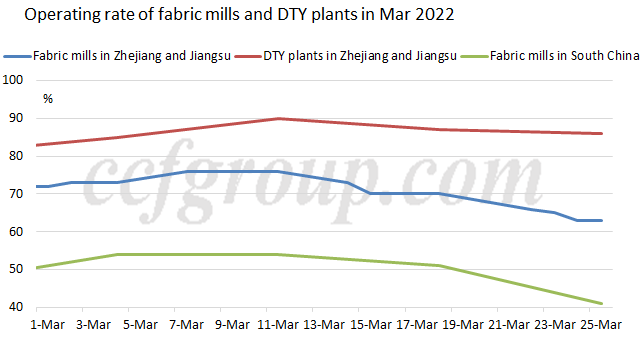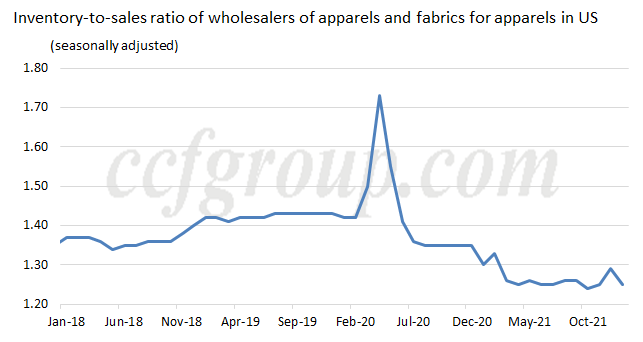China Jan-Feb textiles and apparels market review
March was supposed to be a traditional peak season for textiles and apparels industry. However, in this March, oil price shivered at high level impacted by the Russia-Ukraine conflict, the raise of interest rate in US and the nuclear negotiation of Iran. The spread of pandemic worsened in some regions of China. The logistics were stunted amid the pandemic. Orders on textiles and apparels market still did not show signals to increase even when March ended. Factories saw mounting stocks, tight capital and lower operating rate.
The operating rate of fabrics mills in Zhejiang and Jiangsu, fabric mills in South China and DTY plants in Zhejiang and Jiangsu reduced since mid-Mar, with decrement at 13%, 13% and 4% respectively.


Domestic retail sales and exports of textiles and apparels seemed to be moderate in Jan-Feb, 2022.
During Jan to Feb, the retail sales of garments, footwear, hats and knitwear of enterprises above designated size approached 238.18 billion Yuan, up 4.8% year on year (up 47.6% during the same period of last year). The retail sales of garments of enterprises above designated size was 175.64 billion Yuan, up 3.7% year on year (up 53.1% in the corresponding period of last year). In Jan-Feb, 2022, the online retail sales of clothing inched up by 3.9% year-on-year (up 44.3% over the same period of last year).
According to China Customs, exports of textiles and apparels amounted to US$50.2 billion in Jan-Feb 2022, up 8.9% y-o-y. Among these, textile export value totaled about US$24.74 billion, up by 11.9% y-o-y, and apparel export value reached US$25.46 billion, up by 6.1% y-o-y.
The exports of apparels to US amounted to US$5.93 billion in Jan-Feb 2021, a year-on-year increase of 2.7%, apparently lower than the 24% growth rate in 2021. Exports to EU rose by 9.9% on the year to US$4.96 billion, higher than the average global export growth, those to Japan decreased by 10.5% on annual basis to US$2.22 billion, the only one saw reduction, and those to nations of the Belt and Road grew 15%, higher than the average export growth. Exports to emerging markets were diversified, which rose by 33.7% and 41.1% respectively to ASEAN and Latin America, and those to Middle East and Africa decreased by 6.4% and 9.6% respectively. Exports to Australia, UK and South Korea rose by 12.7%, 7.4% and 10.8% respectively, and those to Russia dropped by 40.6%.
Regarding the relative value, the domestic retail sales of textiles and apparels of Jan-Feb only recovered to the level in the same period of 2018-2019. Consumption was estimated to be greatly affected by the spread of pandemic in Mar, especially after some couriers being infected.
| Domestic retail sales of textiles and apparels | ||
| Date | Domestic retail sales of textiles and apparels (100 Million Yuan) | 2015=100 |
| Jan-Feb, 2015 | 4027.2 | 100 |
| Jan-Feb, 2016 | 4244.3 | 105 |
| Jan-Feb, 2017 | 4420.5 | 110 |
| Jan-Feb, 2018 | 4170.2 | 104 |
| Jan-Feb, 2019 | 4059.8 | 101 |
| Jan-Feb, 2020 | 2637.1 | 65 |
| Jan-Feb, 2021 | 3951.3 | 98 |
| Jan-Feb, 2022 | 4138.2 | 103 |
As for overseas textile and apparel retail sales, 19 countries in the Eurozone and Japan have not yet fully returned to their pre-epidemic levels in 2021. The Eurozone was again stranded by the epidemic at the end of October and early November in 2021. Spain, Britain, France, Germany and other countries have announced blockade measures one after another. The retail sales of textiles and apparels slowed down and fell back.
In Japan, with the decline in the proportion of textile and apparel consumption in Japan's overall retail consumption, textile and apparel retail sales have fallen rapidly since December 2021 and dropped to a low close to the 2020 epidemic in February 2022.
Among Europe, US and Japan, the recovery of retail sales in US was relatively more robust. In US, textile and apparel retail sales have exceeded pre-epidemic levels since the beginning of 2021 stimulated by fiscal subsidy and rebounding confidence of consumers, which have been at a high shock level until February 2022. However, whether the retail sales will reduce remains uncertain after the US dollar interest rate hiked in March 2022.
As for the relative import volume of textiles and apparels in Europe, US and Japan, it have started dropping from the fourth quarter of 2021.
Judging from the inventory-to-sales ratio of wholesalers of apparels and fabrics for apparels in US, it has basically returned to the level of the same period in 2019 at the beginning of 2022. In 2021, as sales recovered well, the inventory-to-sales ratio was still rising in the second half of the year, and the replenishment increment of wholesalers was larger than that of sales increment. In March 2022, with high crude oil price, the enthusiasm of wholesalers to increase inventory may be lower than that in 2021.

In April, the impact of geopolitical factors on crude oil supply and demand may remain, and the Iranian nuclear issue and the Russian-Ukrainian conflict kept unclear in March. Raw materials of textiles and apparels still have risk to fluctuate, but the market players may be more tolerant to the volatility than in March. The demand for textiles and apparels is still under pressure. The control of the epidemic and the recovery of transportation and consumption are still concerns in local China; As for market outside China, tightening monetary policy may have negative effect on consumption, and the momentum of replenishment under high cost may weaken.
- Top keywords
- Cotton Price
- Cotton Futures Price
- Cotton Futures
- CZCE
- PTA Futures Price
- Chemical Fiber
- Polyester Prices
- Wool price
- PTA Futures
- Shengze Silk
- China
- Yarn Price
- price
- China Textile City
- Fibre Price
- Benzene Price
- Cotton
- Index
- Cotton Index
- PTA
- fabric price
- NYMEX
- Top 10
- textile industry
- Spot Cotton
- Cotton Yarn
- Polyester Price
- Futures
- PTA Price
- cotton yarn price

